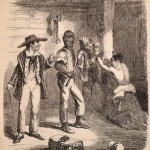
Dijkstra, Bram. Idols of Perversity: Fantasies of Feminine Evil in Fin-De-Siecle Culture Oxford University Press, 1986.
Dijkstra’s book is an overview of art from the mid-nineteenth century to the early twentieth, exploring the recurring themes of artists largely forgotten today. Back then, paintings were an art form viewed by the general public in salons and exhibitions, and having great controversy for their content. In the author’s analysis, there were recurring themes of gender, class and race tangled together in art.
The mid-nineteenth century, circa 1850, saw woman as the “household nun”, the passive vessel where the warrior-merchant man kept his soul for safekeeping. Artists painted sappy sentimental images of mothers and children, nymphs with broken backs languishing in the woods, etc. Around 1870, when the first generation raised under these ideals had matured (and when decadents like Rachile and Sacher-Masoch and Bram Stoker and Flaubert wrote), they took their disappointment in their mothers and wives failing to live up to that ideal as inspiration to portray women as monsters: bestial, materialistic, lustful, full of low cunning, primitive, a snare to trap man on his path to spiritual apotheosis and transcendance of the material. Dualistic thinking combined with garbled Darwin and Schopenhauer.
The cultural leaders of the years around 1900 much preferred the depiction of a simple world of dualistic absolutes, of easily identifiable abject household nuns and monstrous devil-women juxtaposed with godlike imperial males and pitiful effeminate victims. (Pg.393)
It’s not surprising to me that the author explores themes that eventually became staples of BDSM imagery: Orientalist slave women, domineering men, an early examples of forniphilia, the amazon, the temptress, the woman-as-animal, the vampire. Dijkstra goes a little overboard, apparently suggesting that even innocuous images are informed by sexism and racism, or that any juxtaposition of woman and animal in the same painting was understood to be an allusion to full on bestiality. Masochist paintings and novels prompt him to go into a convoluted theory in purple prose about masochists as “executioner’s assistants”.
It’s not that Dijkstra is wrong, it’s that he’s a modernist: his texts have one meaning. If one allows for irony or humor or subversion or fantasy when creating or viewing images, many different stories emerge. The story of Judith and Holofernes can be an instance of female heroism, instead of just a woman consuming the spiritual essence of man to fill her own moral and intellectual vacuum. Dijkstra’s final example is the biblical tale of Salome, which in Oscar Wilde’s version is the conflict of the spiritual/speaking and hearing/man versus the material/seeing and being seen/woman, but remember that in Aubrey Beardsley’s illustrations of the play, Wilde himself is caricatured as Salome’s manipulative mother, Herodias.
Dijkstra has one theme only: man’s sublimated hatred towards woman, which ultimately limits his analysis. He leaves out how people find solutions in fantasy to problems, how symbols that can be monstrous to one viewer or one time can be heroic to another viewer or another time. His book covers the period which I consider the very early roots of the BDSM subculture, circa 1870, the publication date of Venus in Furs and also soon after the first spate of fetishist letters in Englishwoman’s Domestic Magazine.



